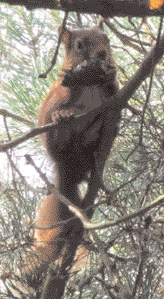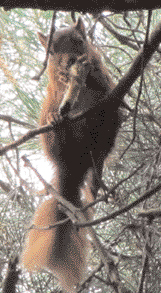| Dalkey Tidy Towns |
  |
| Dalkey Tidy Towns |
  |
Wildlife
Newsletter for the Township of Dalkey September 2010 - Michael Ryan |
| NOT
SO EARLY BIRDS For the last few years I’ve always found myself getting a bit apprehensive if I haven’t heard the squawking call of young Sparrowhawks by mid July. But then inevitably within a few days of the middle of the month we’d hear the young birds, perched on branches somewhere and letting their parents know, in no uncertain terms, where to come to with their next meal. Often there would be two separate sparrowhawk families, one on Dalkey and one on Killiney hill, often emerging at the same time. It might seem late in the year for young birds to be born but sparrowhawks hatch late so their parents can avail of all the young birds in the air as a potential food supply. But when we were entering the last week in July and there wasn’t a screech to be heard I’d given up on them. I was wondering could the Jays be responsible, they’re well known for robbing other bird’s nests and they were nesting very close to where we’d seen the Sparrowhawks. But the Jays were innocent in this case. On the August Bank Holiday weekend the familiar calls sounded from the woods and eventually I saw a young sparrowhawk (pictured above) on a branch of a Douglas Fir, one of the tallest trees in the woods. When I got a bit closer I saw a Wood Pigeon was perched on the next branch up. Maybe it was aware the predator a few feet away from it on the next limb was actually a juvenile presenting it with no threat anyhow it didn’t seem the slightest bit interested in its neighbour although I’m sure if the Sparrowhawk’s mummy appeared it mightn’t hang around |
|
|
Rowan Tree and Buddleia Bush |
BUTTERFLY
BABY FOOD Botanist Declan Dooge of the Dublin Naturalist Field Club led a very entertaining field trip around Sorrento Park in July to look at some of the native and alien flora found in the park. Unfortunately the outing began under a torrential shower, which had swept in over the bay. Declan assembled the hardy group under a tree with the rain bouncing off our umbrellas. He’s very entertaining as well as being very informative and everything that was growing around us was a source of some anecdote or fascinating bit of information. I didn’t even notice for a while that the umbrella the person standing beside me was holding, was directing a little stream of water right down the side of one of my boots. But soon the rain passed over and he was able to show us some of the parks flora and how it survived, or even thrived, so near to the salt water and spray. He made an interesting point about buddleia bushes, a non-native but very common plant.Buddleias are known as the butterfly bush and many people grow them, or tolerate bushes that have self-seeded in their garden, because of their benefit as a butterfly food plant. |
| But then he made the point that although lots of us grow food plants for butterflies in the summer we may not provide food plants for their offspring, the caterpillars, to feed on. Many butterflies lay their eggs on nettles and the emerging caterpillars will feed on the leaves as they grow. But Declan said that he had a sister who, although she had buddleias growing in her garden for the benefit of any visiting butterfly, she wouldn’t, in a fit, allow a nettle grow in her garden. So if you have a little space in your garden and want to help wildlife maybe you’d tolerate a nettle or two. I went a bit too far the other way a few years ago letting a few solitary nettles grow in our garden. Unfortunately now they’re all over the place, spreading by their roots as well as by seeds and if I pull one up I’m afraid I might be dislodging loads of butterfly eggs while getting stung in the process. So I would advise if you want nettles try and keep them in a container or old dustbin where you can keep control of them. Brambles are another good food plant for butterflies and ivy is a good food plant for the caterpillars of Holly Blue butterflies that lay eggs on them in the autumn. Generally native plants are of most benefit to our insects and wildlife but our most common Buddleia, (Buddleia davidii) a native of central China is great for attracting not just butterflies but bees, any many other insects and subsequently attracting birds to feed on these little creatures. A buddleia growing outside our kitchen window also provides us with great close up views of many different birds feeding on spiders and other insects. |
| NEW
DINERS I was interested to hear, after chatting with an old friend, that I wasn’t the only person who was having large numbers of birds coming to their feeders during the summer time. During the months of June and July I was going through a 20 kilo sack of sunflower seeds every ten days or so, even more seed then the birds were taking during the winter. Most of the birds coming were of the seed eating finch family, chaffinch, greenfinch and bullfinch. I mentioned before that it was until recently almost unknown for bullfinches to come to feeders. I’ve had bullfinches coming to the feeders this year for the first time ever and my friends told me that they also had bullfinches eating the sunflower seeds they’d left out. Those birds were miles away from mine and couldn’t possibly be the same individuals. It’s fascinating the way the same species would develop new feeding habits at the same time. Anyhow they’re very welcome, especially the bullfinches, very endearing little birds you’d never get tired of looking at. Quite a few people now get also another species of finch, the Linnet, coming to their feeders so if you regularly leave out food for the birds you never know who might arrive to avail of it. |
  Red Squirrel feeding |
||
|
starting
cone |
finishing
cone |
||
|
Photos
courtesy Michael Ryan |